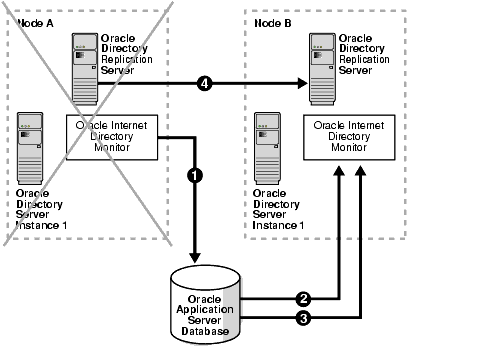10g (9.0.4)
Part Number B12118-01
Home |
Solution Area |
Contents |
Index |
| Oracle® Internet Directory Administrator's Guide 10g (9.0.4) Part Number B12118-01 |
|
Rack-Mounted Directory Server Configurations, 5 of 7
In a rack-mounted environment, the OID Monitor on each node reports to the other nodes that it is running by sending a message to the Oracle9i Database Server every 10 seconds. When it does this, it also polls the database server to verify that all other directory server nodes are also running. If, after 250 seconds, an OID Monitor on one of the nodes has not reported that it is running, then the other directory server nodes regard it as having failed. At this point, the following occurs on one of the other nodes that are still running:
Figure 27-4 and the accompanying text exemplify this process on two hypothetical nodes, Node A and Node B.

As the example in Figure 27-4 shows, the failover process in a rack-mounted environment follows this process:
"Oracle Internet Directory Architecture" for information about directory server nodes, directory server instances, and the kinds of directory metadata stored in the database
See Also:
|
|
 Copyright © 1999, 2003 Oracle Corporation. All Rights Reserved. |
|